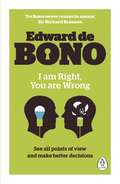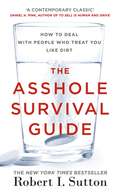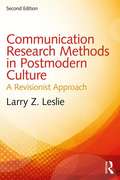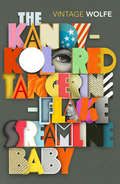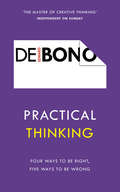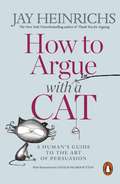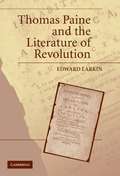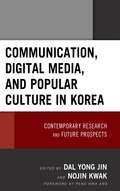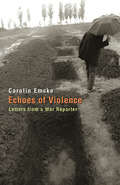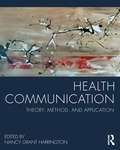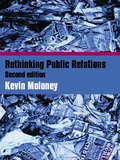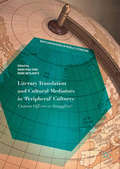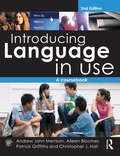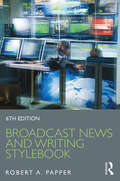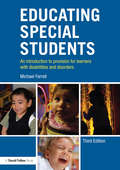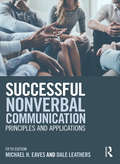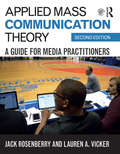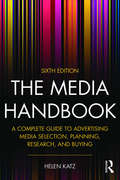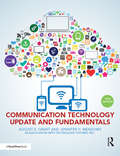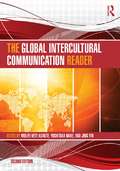- Table View
- List View
I Am Right, You Are Wrong: See All Points Of View And Make Better Decisions
by Edward De BonoI Am Right, You Are Wrong is THE classic work about choice in business and in life from world-renowned writer and philosopher Edward de Bono. Most of our everyday decision-making tends to be confrontational. Whether in large meetings, one-to-one or even in our own heads, opposite view points are pitted against each other. Ultimately, there must be a winner and a loser. In I Am Right,You Are Wrong, lateral-thinking guru Edward de Bono challenges this 'rock logic' of rigid categories and point-scoring arguments which is both destructive and exhausting. Instead he reveals how we can all be winners. Clearer perception is the key to constructive thinking and more open-minded creativity. In overturning conventional wisdom, Edward de Bono will help you to become a better thinker and decision maker. 'An inspiring man with brilliant ideas. De Bono never ceases to amaze with his clarity of thought' Sir Richard Branson
The Asshole Survival Guide: How to Deal with People Who Treat You Like Dirt
by Robert I SuttonFrom the international bestselling expert on dealing with assholes'With cutting-edge research and real-life examples that are thought-provoking and often hilarious, thisis an indispensable resource'Gretchen Rubin, author of The Happiness Project'At last someone has provided clear steps for rejecting, deflecting, and deflating the jerks who blight our lives. Better still, that someone is the great Bob Sutton, which ensures that the information is useful, evidence-based, and fun to read'Robert Cialdini, author of Influence and Pre-Suasion'If only Bob Sutton's book had been available to help me deal with the full complement of 1st-class assholes I've encountered in my 50-year professional life. No names shall be mentioned'Tom Peters, co-author of In Search of ExcellenceBeing around assholes, whether at work or elsewhere, can damage performance and affect wellbeing: having one asshole in a team has been shown to reduce performance by 30 to 40%. And social media has only given rise to further incivility -- 40% of people have experienced harassment online.In The Asshole Survival Guide, Stanford professor Robert Sutton offers practical advice on identifying and tackling any kind of asshole -- based on research into groups from uncivil civil servants to French bus drivers, and 8,000 emails that he has received on asshole behaviour.With expertise and humour, he provides a cogent and methodical game-plan. First, he sets out the asshole audit, to find out what kind of asshole needs dealing with, and asshole detection strategies. Then he reveals field-tested, sometimes surprising techniques, from asshole avoidance and asshole taxes to mind-tricks and the art of love bombing. Finally, he explains the dangers of asshole blindness -- when the problem might be yours truly.Readers will learn how to handle assholes - in the workplace and beyond - once and for all!
Communication Research Methods In Postmodern Culture: A Revisionist Approach
by Larry Z. LeslieThe second edition of Communication Research Methods in Postmodern Culture continues to explore research from a postmodern perspective. Typical qualitative and quantitative research methods are adjusted to fit the needs of contemporary culture. Each chapter is updated with new information and fresh examples. Included in the second edition is a new chapter on Internet and social media research. The author uses straightforward and easy-to-understand language. Both individual and group projects are among the suggested activities. This book is important for the study of communication in a changing political, social, economic, and technological environment.
Communication Research Methods In Postmodern Culture: A Revisionist Approach
by Larry Z. LeslieThe second edition of Communication Research Methods in Postmodern Culture continues to explore research from a postmodern perspective. Typical qualitative and quantitative research methods are adjusted to fit the needs of contemporary culture. Each chapter is updated with new information and fresh examples. Included in the second edition is a new chapter on Internet and social media research. The author uses straightforward and easy-to-understand language. Both individual and group projects are among the suggested activities. This book is important for the study of communication in a changing political, social, economic, and technological environment.
The Kandy-Kolored Tangerine-Flake Streamline Baby (Picador Bks.)
by Tom WolfeTom Wolfe's debut collection of essays - a brilliant, form-bending dive into the future of America as it careened through the 1960s In 1965, Tom Wolfe dropped like a bomb onto the American literary scene with his first book, The Kandy-Kolored Tangerine-Flake Streamline Baby, an incandescent panorama of American counter-culture, its dances, bouffant hairdos, customised cars and rock concerts. Capturing the energy of the age in its portraits of Phil Spector, Cassius Clay, Las Vegas and the Nanny Mafia – as well as asking, why do doormen hate Volkswagens? – Wolfe’s flamboyant essay collection remains one of the great, revolutionary landmarks of modern non-fiction.'Journalism, it is said, is the first draft of history. Nobody exemplifies the dictum better than Wolfe, the cultural observer and social critic par excellence' Daily Telegraph
Practical Thinking: Four Ways to be Right, Five Ways to be Wrong (Pelican Ser.)
by Edward De BonoIn Practical Thinking de Bono’s theme is everyday thinking, how the mind actually works – not how philosophers think it should. Based on the results of his famous Black Cylinder Experiment (a critical thinking task that asks participants why they think a black cylinder falls over), de Bono explores the four practical ways of being right. From there he picks out and names the five levels of understanding – and the five major mistakes in thinking. From memes and Instagram to twitter and bestselling books like Mistakes I Made At Work, mistakes – and what we can learn from them – are a hot topic. With Edward you’ll learn exactly why we all make them.
How to Argue with a Cat: A Human's Guide to the Art of Persuasion
by Jay HeinrichsIf you can persuade a cat ... you can persuade anyone. This is the essential guide to getting your way. Jay Heinrichs, award-winning author of Thank You for Arguing and advisor to the Pentagon, NASA and Fortune 500 companies, distils a lifetime of negotiating and rhetoric to show you how to win over anyone - from colleagues and bosses, to friends and partners at home (and even the most stubborn of feline adversaries).You'll learn to:Perfect your timing - learn exactly when to pounceGet your body language, tone and gesture just rightThink about what your opponent wants - always offer a comfy lapLure them in by making them think they have the powerThe result? A happy, hopefully scratch-free, resolution.'Jay Heinrichs knows a thing or two about arguing' The Times'A master rhetorician and persuasion guru' Salon'You got a bunch of logical engineers to inject pathosinto their arguments ... it works!' NASA engineer
Thomas Paine and the Literature of Revolution (PDF)
by Edward LarkinAlthough the impact of works such as Common Sense and The Rights of Man has led historians to study Thomas Paine's role in the American Revolution and political scientists to evaluate his contributions to political theory, scholars have tacitly agreed not to treat him as a literary figure. This book not only redresses this omission, but also demonstrates that Paine's literary sensibility is particularly evident in the very texts that confirmed his importance as a theorist. And yet, because of this association with the 'masses', Paine is often dismissed as a mere propagandist. Thomas Paine and the Literature of Revolution recovers Paine as a transatlantic popular intellectual who would translate the major political theories of the eighteenth century into a language that was accessible and appealing to ordinary citizens on both sides of the Atlantic.
Communication, Digital Media, And Popular Culture In Korea: Contemporary Research And Future Prospects (PDF)
by Kim Jin Youm PaeIn recent decades, Korean communication and media have substantially grown to become some of the most significant segments of Korean society. Since the early 1990s, Korea has experienced several distinctive changes in its politics, economy, and technology, which are directly related to the development of local media and culture. Korea has greatly developed several cutting-edge technologies, such as smartphones, video games, and mobile instant messengers to become the most networked society throughout the world. As the Korean Wave exemplifies, the once small and peripheral Korea has also created several unique local popular cultures, including television programs, movies, and popular music, known as K-pop, and these products have penetrated many parts of the world. As Korean media and popular culture have rapidly grown, the number of media scholars and topics covering these areas in academic discourses has increased. These scholars' interests have expanded from traditional media, such as Korean journalism and cinema, to several new cutting-edge areas, like digital technologies, health communication, and LGBT-related issues. In celebrating the Korean American Communication Association's fortieth anniversary in 2018, this book documents and historicizes the growth of growing scholarship in the realm of Korean media and communication.
Echoes of Violence: Letters from a War Reporter (PDF) (Human Rights and Crimes against Humanity #1)
by Carolin Emcke"Nobody I ever met on my assignments . . . asked me for direct, practical help. . . . But over and over again people have asked me: 'Will you write this down?' "--Echoes of Violence ? Echoes of Violence is an award-winning collection of personal letters to friends from a foreign correspondent who is trying to understand what she witnessed during the iconic human disasters of our time--in Iraq, Lebanon, Afghanistan, and New York City on September 11th, among many other places. Originally addressing only a small group of friends, Carolin Emcke started the first letter after returning from Kosovo, where she saw the aftermath of ethnic cleansing in 1999. She began writing to overcome her speechlessness about the horrors of war and her own sense of failure as a reporter. Eventually, writing a letter became a ritual Emcke performed following her return from each nightmare she experienced. First published in 2004 to great acclaim, Echoes of Violence in 2005 was named German political book of the year and was a finalist for the international Lettre-Ulysses award for the art of reportage. Combining narrative with philosophic reflection, Emcke describes wars and human rights abuses around the world--the suffering of civilians caught between warring factions in Colombia, the heartbreaking plight of homeless orphans in Romania, and the near-slavery of garment workers in Nicaragua. Freed in the letters from journalistic conventions that would obscure her presence as a witness, Emcke probes the abyss of violence and explores the scars it leaves on landscapes external and internal.
Health Communication: Theory, Method, and Application
by Nancy Grant HarringtonHealth Communication provides coverage of the major areas of interest in the field of health communication, including interpersonal, organizational, and health media. It takes an in-depth approach to health communication research by analyzing and critically evaluating research conducted across multiple paradigmatic perspectives. This edited textbook includes chapters covering such topics as: interpersonal health communication issues, challenges, and complexities in health communication, communication aspects of health behaviors and conditions, organizational issues in health communication, and media and eHealth research. Chapters have been contributed by noted researchers and educators in health communication and represent the current state of the field. They offer pedagogical features that will prove useful to students and instructors of health communication, such as sidebars, summary boxes, suggestions for in-class activities, discussion questions, and lists of additional resources. A companion website provides online resources for use with this text, including: For students: Test questions Downloadable flash cards Exam study guides For instructors: PowerPoint slides Sample syllabi Sample assignments Developed for use in upper-level health communication courses, this text represents the breadth and depth of health communication theory and research as it exists today.
Health Communication: Theory, Method, and Application
by Nancy Grant HarringtonHealth Communication provides coverage of the major areas of interest in the field of health communication, including interpersonal, organizational, and health media. It takes an in-depth approach to health communication research by analyzing and critically evaluating research conducted across multiple paradigmatic perspectives. This edited textbook includes chapters covering such topics as: interpersonal health communication issues, challenges, and complexities in health communication, communication aspects of health behaviors and conditions, organizational issues in health communication, and media and eHealth research. Chapters have been contributed by noted researchers and educators in health communication and represent the current state of the field. They offer pedagogical features that will prove useful to students and instructors of health communication, such as sidebars, summary boxes, suggestions for in-class activities, discussion questions, and lists of additional resources. A companion website provides online resources for use with this text, including: For students: Test questions Downloadable flash cards Exam study guides For instructors: PowerPoint slides Sample syllabi Sample assignments Developed for use in upper-level health communication courses, this text represents the breadth and depth of health communication theory and research as it exists today.
Rethinking Public Relations: PR Propaganda and Democracy
by Kevin MoloneyAll PR, whether for charities or arms manufacturers, is weak propaganda. Though it has its undeniable benefits (it grabs attention and helps circulate more information), it also has costs (such as selective messaging). This extensively revised edition of a classic text fully investigates PR, updating and expanding earlier arguments and building upon the successful first edition with new thoughts, data and evidence. Thought-provoking and stimulating, Rethinking Public Relations 2nd Edition challenges conventional PR wisdom. It develops the accepted thinking on the most important question facing PR - its relationship with democracy - and finds a balance of advantages and disadvantages which leave a residue of concern. It tackles topical issues such as: PR as a form of propaganda which flourishes in a democracy the connections between PR and journalism the media, promotions culture and persuasion. Designed to appeal to final year undergraduates, postgraduates and researchers studying public relations, media and communications studies, this book explores the most important relationship PR has – the connection with democracy – and asks what benefits or costs it brings to politics, markets and the media.
Literary Translation and Cultural Mediators in 'Peripheral' Cultures: Customs Officers or Smugglers? (New Comparisons in World Literature)
by Diana Roig-Sanz Reine MeylaertsThis book sets the grounds for a new approach exploring cultural mediators as key figures in literary and cultural history. It proposes an innovative conceptual and methodological understanding of the figure of the cultural mediator, defined as a cultural actor active across linguistic, cultural and geographical borders, occupying strategic positions within large networks and being the carrier of cultural transfer. Many studies on translation and cultural mediation privileged the major metropolis of Paris, London, and New York as centres of cultural production and translation. However, other cities and megacities that are not global centres of culture also feature vibrant translation scenes. This book abandons the focus on ‘innovative’ centres and ‘imitative’ peripheries and follows processes of cultural exchange as they develop. Thus, it analyses the role of cultural mediators as customs officers or smugglers (or both in different proportions) in so-called ‘peripheral’ cultures and offers insights into an under-analysed body of actors and institutions promoting intercultural transfer in often multilingual and less studied venues such as Trieste, Tel Aviv, Buenos Aires, Lima, Lahore, or Cape Town.
Literary Translation and Cultural Mediators in 'Peripheral' Cultures: Customs Officers or Smugglers? (New Comparisons in World Literature)
by Diana Roig-Sanz Reine MeylaertsThis book sets the grounds for a new approach exploring cultural mediators as key figures in literary and cultural history. It proposes an innovative conceptual and methodological understanding of the figure of the cultural mediator, defined as a cultural actor active across linguistic, cultural and geographical borders, occupying strategic positions within large networks and being the carrier of cultural transfer. Many studies on translation and cultural mediation privileged the major metropolis of Paris, London, and New York as centres of cultural production and translation. However, other cities and megacities that are not global centres of culture also feature vibrant translation scenes. This book abandons the focus on ‘innovative’ centres and ‘imitative’ peripheries and follows processes of cultural exchange as they develop. Thus, it analyses the role of cultural mediators as customs officers or smugglers (or both in different proportions) in so-called ‘peripheral’ cultures and offers insights into an under-analysed body of actors and institutions promoting intercultural transfer in often multilingual and less studied venues such as Trieste, Tel Aviv, Buenos Aires, Lima, Lahore, or Cape Town.
Introducing Language in Use: A Course Book
by Andrew John Merrison Aileen Bloomer Patrick Griffiths Christopher J. HallIntroducing Language in Use, second edition, provides a lively and accessible introduction to the study of language and linguistics. Drawing on a vast range of data and examples of language in its many forms, this book provides students with the tools they need to analyse real language in diverse contexts. The second edition of this best-selling textbook has been fully revised and updated with entirely new chapters on Phonology and Sociolinguistics, two separate chapters on syntax and grammar, completely rewritten chapters on Multilingualism, Psycholinguistics and World Englishes, and a greater focus on corpus linguistics. Introducing Language in Use: covers all the core areas and topics of language study, including semiotics, communication, grammar, phonetics, phonology, words, semantics, variety in language, history of English, world Englishes, multilingualism, psycholinguistics, sociolinguistics, language acquisition, conversation analysis, pragmatics and politeness adopts a 'how to' approach, encouraging students to apply their knowledge as they learn it draws on examples of language from around the world in forms ranging from conversation to advertising and text messaging, always giving precedence to real language in use includes activities throughout the text and an extensive glossary of terms The book is supported by a companion website offering a wealth of additional resources including commentaries on the activities in the book, suggested further reading and references, links to useful websites, more texts to analyse, additional web activities, ‘fun with language’ exercises, discussion questions and an additional ‘Language in Education’ chapter. This is an essential coursebook for all introductory courses in English language, communication and linguistics. Visit the companion website at www.routledge.com/cw/merrison
Introducing Language in Use: A Course Book
by Andrew John Merrison Aileen Bloomer Patrick Griffiths Christopher J. HallIntroducing Language in Use, second edition, provides a lively and accessible introduction to the study of language and linguistics. Drawing on a vast range of data and examples of language in its many forms, this book provides students with the tools they need to analyse real language in diverse contexts. The second edition of this best-selling textbook has been fully revised and updated with entirely new chapters on Phonology and Sociolinguistics, two separate chapters on syntax and grammar, completely rewritten chapters on Multilingualism, Psycholinguistics and World Englishes, and a greater focus on corpus linguistics. Introducing Language in Use: covers all the core areas and topics of language study, including semiotics, communication, grammar, phonetics, phonology, words, semantics, variety in language, history of English, world Englishes, multilingualism, psycholinguistics, sociolinguistics, language acquisition, conversation analysis, pragmatics and politeness adopts a 'how to' approach, encouraging students to apply their knowledge as they learn it draws on examples of language from around the world in forms ranging from conversation to advertising and text messaging, always giving precedence to real language in use includes activities throughout the text and an extensive glossary of terms The book is supported by a companion website offering a wealth of additional resources including commentaries on the activities in the book, suggested further reading and references, links to useful websites, more texts to analyse, additional web activities, ‘fun with language’ exercises, discussion questions and an additional ‘Language in Education’ chapter. This is an essential coursebook for all introductory courses in English language, communication and linguistics. Visit the companion website at www.routledge.com/cw/merrison
Broadcast News and Writing Stylebook
by Robert A. PapperPapper’s Broadcast News and Writing Stylebook is the go-to handbook in broadcast news, and with the updates in the 6th edition, it is sure to continue this legacy. Through clear and concise chapters, this text provides the fundamental rules of broadcast news writing. It covers various fields across the board, including crime and government, weather, education, health, and sports. Within each field, readers learn the nuances of reporting, grammar, style, and usage. Written by a professional who has overseen major industry research for the past 23 years, this edition presents the data on news writing in a relevant and digestible manner. With the business of broadcast news changing rapidly, this text reflects the current news environment and explores where it will head in the future. With an expanded social media chapter and additional insight into the news rooms of today, Broadcast News and Writing Stylebook incorporates all the skills and knowledge reporters and journalist need to prepare for their careers.
Educating Special Students: An introduction to provision for learners with disabilities and disorders
by Michael FarrellEducating Special Students is the definitive guide to evidence based practice and professionally informed approaches to provision for special students. Now in its third edition, the book sets out ideas of best practice relating to different disabilities and disorders, helpfully discussing what might constitute effective provision. This edition has been updated to take account of new ways of classifying disabilities and disorders, and recent developments in research and practice, including the 2014 SEND Code of Practice (England) and the Diagnostic and Statistical Manual of Mental Disorders Fifth Edition DSM-5™. A new appendix provides information on basic anatomy and physiology. International in scope, the book explores issues relating to: intellectual disability (profound, moderate to severe, and mild) sensory impairments orthopaedic impairment and motor disorders, health impairments, and traumatic brain injury oppositional defiant disorder, conduct disorder, anxiety disorders, depressive disorders, and attention deficit hyperactivity disorder communication disorders (speech, grammar and comprehension, semantics and pragmatics), and autism spectrum disorder specific learning disorders with impairment in reading, written expression and mathematics, and developmental co-ordination disorder. Educating Special Students will be of interest to all those studying special education, professionals, and others committed to seeking the best provision for special students.
Successful Nonverbal Communication: Principles and Applications
by Michael Eaves Dale G. LeathersSuccessful Nonverbal Communication: Principles and Applications demonstrates how knowledge of nonverbal messages can affect successful communication in the real world. Now with fifteen chapters, the fifth edition draws students in through applications of the latest nonverbal communication research and through current examples of celebrities, sports, and politicians. This extensive revision describes nonverbal cues and their desirable and undesirable functions while offering original tests for measuring and developing nonverbal communication skills. Updates include new attention to Donald Trump, Hillary Clinton, and Barack Obama, and discussion of nonverbal communication within same-sex partnerships.
Applied Mass Communication Theory: A Guide for Media Practitioners
by Jack Rosenberry Lauren A. VickerApplied Mass Communication Theory: A Guide for Media Practitioners, Second Edition bridges a review of theory to the contemporary work of media professionals. The text provides a framework for constructing an undergraduate research project. It also presents vital chronological information on the progression of theory in mass communication, including a model that integrates mass communication theories and shows how they relate to one another. It concludes with information on media law, ethics, economics, and mass media careers, establishing a critical framework for students as they leave college and begin their first jobs. This Second Edition discusses mass communication theory and its applications in both traditional print and broadcast applications. By exploring advertising and public relations in this new digital multi-media environment, this text remains relevant, and in fact necessary, for students in the field.
The Media Handbook: A Complete Guide to Advertising Media Selection, Planning, Research, and Buying (Lea’s Communication Series)
by Helen KatzThe Media Handbook provides a practical introduction to the advertising media planning and buying processes. Emphasizing basic calculations and the practical realities of offering alternatives and evaluating the plan, this sixth edition reflects the critical changes in how advertising in various media is planned, bought, and sold by today’s industry professionals. Author Helen Katz looks at the larger marketing, advertising, and media objectives, and follows with an exploration of major media categories, covering paid, owned, and earned media forms, including digital media. She provides a comprehensive analysis of planning and buying, with a continued focus on how those tactical elements tie back to the strategic aims of the brand and the client. Also available is a Companion Website that expands The Media Handbook’s content in an online forum. Here, students and instructors can find tools to enhance course studies such as chapter overviews, PowerPoint slides, and sample questions. With its emphasis on real-world industry practice, The Media Handbook provides an essential introduction to students in advertising, media planning, communication, and marketing. It serves as an indispensable reference for anyone pursuing a career in media planning, buying, and research.
Communication Technology Update and Fundamentals: 15th Edition
by August E. Grant Jennifer H. MeadowsCommunication Technology Update and Fundamentals has set the standard as the single best resource for students and professionals looking to brush up on how communication technologies have developed, grown, and converged, as well as what’s in store for the future. The 15th edition is completely updated, reflecting the changes that have swept the communication industries. The first five chapters offer the communication technology fundamentals, including the ecosystem, the history, and structure—then delves into each of about two dozen technologies, including mass media, computers, consumer electronics, and networking technologies. Each chapter is written by experts who provide snapshots of the state of each individual field. Together, these updates provide a broad overview of these industries, as well as the role communication technologies play in our everyday lives. In addition to substantial updates to each chapter, the 15th edition includes: First-ever chapters on Big Data and the Internet of Things Updated user data in every chapter Projections of what each technology will become by 2031 Suggestions on how to get a job working with the technologies discussed The companion website, www.tfi.com/ctu, offers updated information on the technologies covered in this text, as well as links to other resources
Communication Technology Update and Fundamentals: 15th Edition
by August E. Grant Jennifer H. MeadowsCommunication Technology Update and Fundamentals has set the standard as the single best resource for students and professionals looking to brush up on how communication technologies have developed, grown, and converged, as well as what’s in store for the future. The 15th edition is completely updated, reflecting the changes that have swept the communication industries. The first five chapters offer the communication technology fundamentals, including the ecosystem, the history, and structure—then delves into each of about two dozen technologies, including mass media, computers, consumer electronics, and networking technologies. Each chapter is written by experts who provide snapshots of the state of each individual field. Together, these updates provide a broad overview of these industries, as well as the role communication technologies play in our everyday lives. In addition to substantial updates to each chapter, the 15th edition includes: First-ever chapters on Big Data and the Internet of Things Updated user data in every chapter Projections of what each technology will become by 2031 Suggestions on how to get a job working with the technologies discussed The companion website, www.tfi.com/ctu, offers updated information on the technologies covered in this text, as well as links to other resources
The Global Intercultural Communication Reader
by Molefi Kete Asante Yoshitaka Miike Jing YinThe Global Intercultural Communication Reader is the first anthology to take a distinctly non-Eurocentric approach to the study of culture and communication. In this expanded second edition, editors Molefi Kete Asante, Yoshitaka Miike, and Jing Yin bring together thirty-two essential readings for students of cross-cultural, intercultural, and international communication. This stand-out collection aims to broaden and deepen the scope of the field by placing an emphasis on diversity, including work from authors across the globe examining the processes and politics of intercultural communication from critical, historical, and indigenous perspectives. The collection covers a wide range of topics: the emergence and evolution of the field; issues and challenges in cross-cultural and intercultural inquiry; cultural wisdom and communication practices in context; identity and intercultural competence in a multicultural society; the effects of globalization; and ethical considerations. Many readings first appeared outside the mainstream Western academy and offer diverse theoretical lenses on culture and communication practices in the world community. Organized into five themed sections for easy classroom use, The Global Intercultural Communication Reader includes a detailed bibliography that will be a crucial resource for today's students of intercultural communication.
